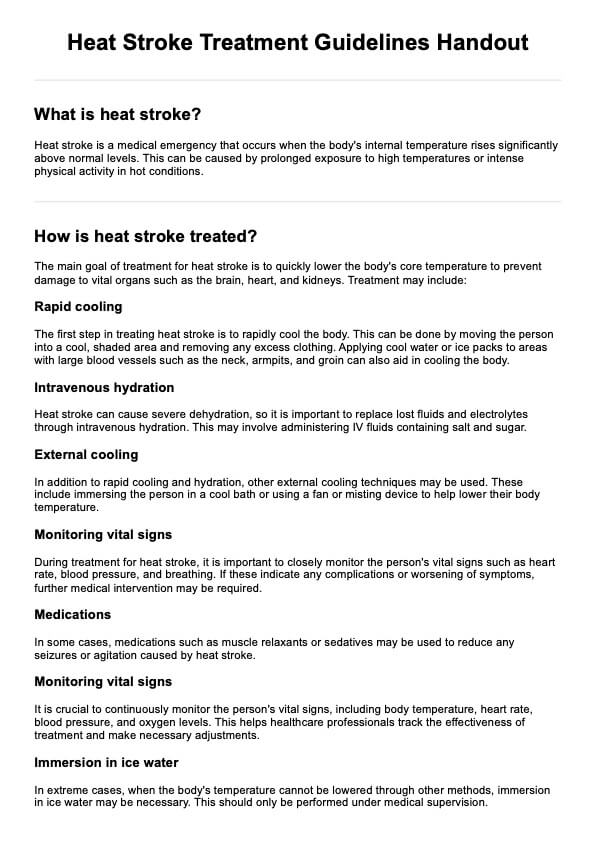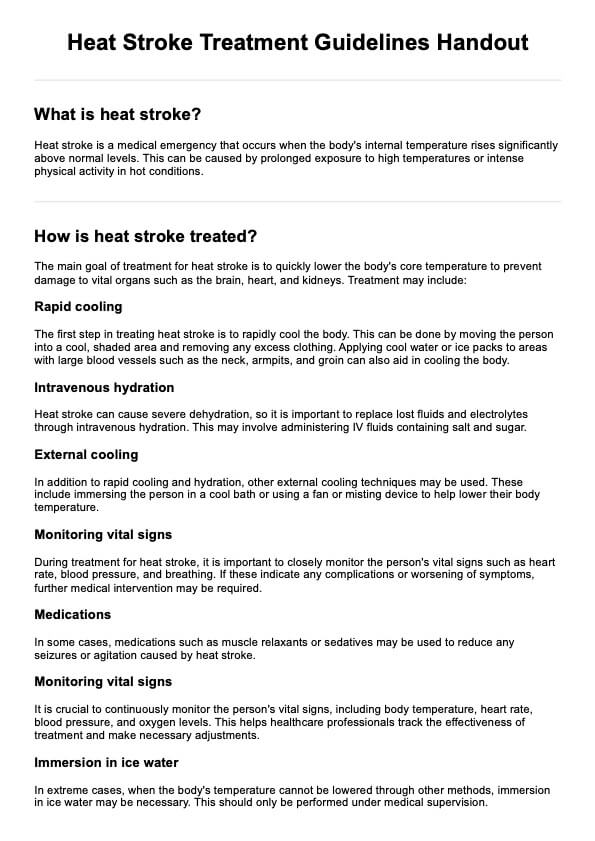Heat Stroke Treatment Guidelines Handout
Learn about heat stroke treatment guidelines with Carepatron's free PDF download. Find information on how to treat heat stroke effectively with an example handout.


What is heat stroke?
Heat stroke is a severe heat-related illness that occurs when the body's core temperature rises above 104°F (40°C) due to prolonged exposure to extreme heat or intense physical exertion in hot weather. It is a critical condition that can lead to serious complications or even death if not treated promptly.
Heat stroke can be categorized into two types: exertional heat stroke, which occurs in individuals engaging in strenuous physical activity, and classic heat stroke, which typically affects vulnerable populations such as the elderly, infants, and those with chronic illnesses.
Heat stroke impairs the body's ability to regulate the central nervous system and core temperature, leading to symptoms such as confusion, seizures, loss of consciousness, and hot, dry skin. Unlike milder heat-related illnesses like heat cramps and heat exhaustion, heat stroke requires immediate medical attention. Effective treatment strategies include rapid cooling techniques such as cold water immersion, ice bath, or applying ice packs to the neck, armpits, and groin. Providing cold drinks and moving heat stroke patients to an air-conditioned environment are also crucial steps.
Understanding the risk factors, such as high humidity, lack of acclimatization, and inadequate hydration, is essential in preventing exertional heat illness and other heat-related illnesses. Prompt recognition and treatment of heat stroke are vital to reduce the incidence of heat-related deaths.
Symptoms of heat stroke
Recognizing the heat stroke symptoms is crucial for prompt treatment and prevention of serious complications. Heat stroke can develop quickly and may become life-threatening if not addressed immediately. Here are the key symptoms to watch for:
- High core body temperature: A core body temperature of 104°F (40°C) or higher is the main sign of heat stroke.
- Altered mental state or behavior: Confusion, agitation, slurred speech, irritability, delirium, seizures, or coma can occur.
- Hot, dry skin or profuse sweating: Skin may feel hot and dry to the touch, or there may be heavy sweating, especially in exertional heat stroke.
- Nausea and vomiting: Feeling sick to the stomach or vomiting is common.
- Flushed skin: The skin may appear red as the body temperature increases.
- Rapid breathing: Breathing may become quick and shallow.
- Racing heart rate: The pulse may become significantly increased because of the heat stress.
- Headache: A throbbing headache is a common symptom.
- Dizziness or light-headedness: Feeling faint or light-headed can occur as the body overheats.
- Muscle weakness or cramps: Heat-related illnesses often cause muscle cramps and weakness.
Heat Stroke Treatment Guidelines Handout Template
Heat Stroke Treatment Guidelines Handout Example
How is heat stroke detected and diagnosed?
Detecting and diagnosing heat stroke promptly is essential to prevent severe complications. Classic heatstroke is a serious heat-related illness that requires immediate medical attention. The diagnostic process involves several steps to confirm the condition and differentiate it from other heat injuries, such as heat exhaustion. Here are the key steps involved in detecting and diagnosing heat stroke:
Assessing symptoms and risk factors
Healthcare providers first evaluate the patient's symptoms and consider risk factors such as prolonged exposure to extreme heat, recent physical exertion, and lack of access to air conditioning. Symptoms like confusion and a high core body temperature are critical indicators of heat stroke.
Measuring core body temperature
Accurately measuring the patient's core body temperature is crucial. A core body temperature of 104°F (40°C) or higher typically confirms heat stroke. This can be done using a rectal thermometer, which provides the most accurate reading in such cases.
Physical examination
A thorough physical examination helps identify signs of heat stroke and differentiate it from other heat-related illnesses, such as heat exhaustion. Healthcare providers look for symptoms like rapid breathing, racing heart rate, flushed skin, and muscle weakness.
Reviewing patient history
Reviewing the patient's recent activities and medical history is essential to understand the context of the heat-related illness. Information about exposure to extreme heat, physical exertion, hydration status, and any pre-existing medical conditions can provide valuable insights.
Conducting laboratory tests
In some cases, laboratory tests may be conducted to assess the severity of the heat injury and rule out other conditions. These tests can include blood tests to check for electrolyte imbalances, kidney function, and other indicators of heat-related damage.
Monitoring and immediate treatment
Once heat stroke is suspected, immediate treatment begins even as differential diagnosis continues. Rapid cooling methods, such as immersion in cool water or apply ice packs or cooling blankets, are initiated to lower the body temperature. Continuous monitoring of vital signs and core temperature is critical during this phase.
How do healthcare professionals treat heat stroke?
Treating heat stroke needs emergency medical services and immediate intervention to prevent severe complications and death. Healthcare professionals employ various heatstroke treatment methods to rapidly reduce the body’s temperature and stabilize the patient. Here are five key treatment options:
1. Rapid cooling techniques
The primary goal in treating heat stroke is to lower the core body temperature as quickly as possible. This can be achieved through two ways: cold water immersion and using an ice pack. Cold water immersion is when a patient submerges in a tub of cold water is one of the most effective methods to cool the body rapidly.
Moreover, placing an ice pack on the patient’s neck, armpits, and groin helps reduce temperature by cooling major blood vessels.
2. Evaporative cooling
Evaporative cooling involves spraying the patient with cool water and using fans to accelerate the evaporation process, thereby cooling the skin and reducing body temperature. This method leverages the body’s ability to lose heat through evaporation.
3. Moving to a cooler environment
Immediately relocating the patient to a cooler environment, such as an air-conditioned room, helps to halt the progression of heat-related illness. Reducing ambient temperature is crucial in both classic heat stroke and exertional heat stroke cases.
4. Intravenous hydration
Administering intravenous (IV) fluids is essential to treat dehydration and maintain blood pressure. This method is particularly important if the patient is unable to drink cool water or if they exhibit symptoms of heat exhaustion, such as nausea and vomiting.
5. Monitoring and supportive care
Continuous monitoring of the patient’s vital signs, including core body temperature, heart rate, and respiratory rate, is critical. Supportive care may include oxygen therapy if respiratory distress is present, and medications to manage seizures or shivering, which can impede the cooling process.
Commonly asked questions
No, heat stroke is a medical emergency. Immediate medical attention is necessary to lower the body's temperature effectively and prevent serious complications.
Move to a cooler place, rest, and drink cool fluids. Apply cool, wet cloths to the skin or take a cool shower to help cool down.
The fastest way to treat heat stroke is rapid cooling, such as immersion in cold water or applying an ice pack to critical areas like the neck, armpits, and groin.
Recovery time varies but typically improves within a few days with proper medical treatment and rest. However, severe cases may require longer recovery periods and ongoing monitoring.







































































































